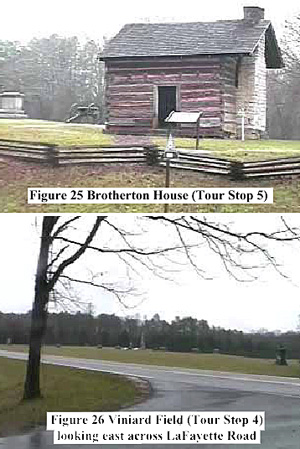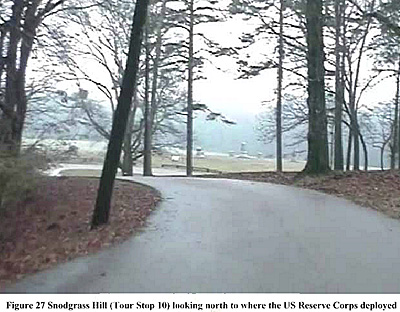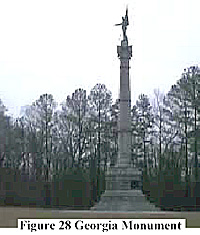 Today is 4 December and it is overcast with a steady light rainfall. This weather
persisted all day, although the rain did not increase in intensity.
Today is 4 December and it is overcast with a steady light rainfall. This weather
persisted all day, although the rain did not increase in intensity.
Allie and I drove along Interstate 75 to Interstate 24 and took Exit 180B along Highway 27 to the visitors’ centre of the battlefield park. I left Allie to guard the Jeep (no pets allowed in the museum) and entered the visitors’ centre. Here I picked up the park brochure with tour and trail information contained on the map, and watched the movie about the battle narrated by Stephen Lang, who played TJ “Stonewall” Jackson in “Gods and Generals” and G Pickett in “Gettysburg”. I also met two members from a group of British officers attending Staff College in the UK, and was visiting Fort Benning, Georgia. They were being given a ranger-guided tour of the park.
I bought a copy of the “Chickamauga Field Guild” that included an audiocassette
narrated by Peter Cozzens, the author of three books on the Battles of Stones River,
Chickamauga and Chattanooga. I had bought the three books at bookstores earlier in my
tour so I had had the chance to skim through his information on the campaigns from
Murfreesboro to Chattanooga. The guide suggested that the tour would take under two
hours, although it took me closer to four as I was using my video camera and getting lost
in my travels.
 I followed the detailed map in the guide, while listening to the tape as I drove. I stopped
at the major points along the tour, which included:
I followed the detailed map in the guide, while listening to the tape as I drove. I stopped
at the major points along the tour, which included:
- 1. Reed’s Bridge (the first clash),
2. Winfrey Field,
3. Brock Field,
4. Viniard Field,
5. Brotherton Field,
6. Poe Field,
7. Kelly Field,
8. Dyer Field,
9. Lytle Hill, and
10. Snodgrass Hill
The first six were sites of conflict on the first day of the battle and lay east of or along LaFayette Road, which splits the park roughly down the centre from north to south. Kelly, Poe and Brotherton Fields were scenes of the second day’s fighting, particularly in the morning. Dyer Field, Lytle Hill and Snodgrass Hill were locations of fighting later in the day with the last being the position held by US General GH Thomas until nightfall on the second day. This is where Thomas gained the title “Rock of Chickamauga”.
Of note, Chickamauga (with Chattanooga) was the first national military park, established on 19 August 1890. The US Congress went on to establish parks at Shiloh, Gettysburg and Vicksburg by 1899. The federal government recognised that the first park featured some of the most formidable natural obstacles to military operations in the world. The purpose of the park was to preserve the land as it had been during the battles, which was possible as there had been few changes in the intervening years.
 There are 1,400 markers and monuments inside and outside the park that record the positions of
units and formations during the battles as well as important landmarks such as the
Snodgrass house and other buildings, and spots like that where US General WH Lytle
was killed.
There are 1,400 markers and monuments inside and outside the park that record the positions of
units and formations during the battles as well as important landmarks such as the
Snodgrass house and other buildings, and spots like that where US General WH Lytle
was killed.
The park is well laid out for study by professional military and historical study. Thus it was no surprise to meet British officers partaking in a professional battlefield study, just fortuitous for me.
I did not have enough time to see all of the museum and browse through the bookstore, so I planned to so the next day. The visitors’ centre was closed by the time I finished my tour about 1645 hours.
Back to Sabretache # 6 Table of Contents
Back to Sabretache List of Issues
Back to MagWeb Master Magazine List
© Copyright 2003 by Terry Gore
This article appears in MagWeb.com (Magazine Web) on the Internet World Wide Web. Other articles from military history and related magazines are available at http://www.magweb.com